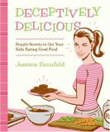Master of Deception

When Laurel moved from purees to finger foods, I thought I was so done with the Cuisinart. And I never imagined that I’d be so excited to steam and puree again (especially for a peanut with a capable, full set of teeth), until I received Jessica Seinfeld’s Deceptively Delicious, which I’m reviewing today per The Parent Bloggers Network.
Through toddlerhood to present, Laurel has followed what seems like a fairly common trajectory; initially (and seemingly lovingly) devouring everything and anything we put in front of her, to boycotting all but cheese, Cheerios, blueberries, and tofu, to then eating well again, save picking out even the tiniest bits of green matter out of her foods (fine motor control skills, check). Throughout it all, we’ve stuck by the mantra that our job is to put the good options in front of her (i.e., not be a short order cook, or cram/bribe veggies down her throat). We were rewarded this summer with a streak of unexpected voluntary vegetable consumption from the bounties of our first little garden, but otherwise, Laurel has remained steadfast in her avoidance of veggies, no matter how simply or complexly we prepare them.
I have to admit that I initially was a little skeptical of Deceptively Delicious, purely due to the celebrity factor, but there’s a lot that I really love about this cookbook; the first being that this book really and truly feels like Seinfeld’s (i.e., not a fleet of ghostwriters). She properly credits the nutritionist and professional chef that helped bring the book together, and weaves in her own commentary, and that of her family, other parents, and parenting experts, in a conversational, engaging tone that refreshingly sets Seinfeld on the same playing field as the rest of us: she's a committed and loving parent who found herself melting down under the annoying stress and frustration of all those veggies rejected and wasted.
Deceptively Delicious is thoughtfully crafted from start to finish. Presented via retro styled illustrations and typesetting, Seinfeld walks you through how to ready your kitchen and pantry for pureeing, nutritionist Joy Bauer provides simple nutritional guidelines for kids (including helpful notes on the benefits and nutritional content of various fruits and vegetables), and then recipes for breakfast, mealtime, and dessert follow. The recipes include an array of traditional family favorites that are easy to knock together, and the cookbook earns major props both for encouraging the use of, for example, whole wheat and trans-fat-free ingredients, and for presentation via spiral binding and with photographs accompanying almost every recipe (two basic features that improve my usage and enjoyment of cookbooks enormously).
These days I need more steps in the kitchen like I need a hole in the head, so engaging in the puree prep and usage process was a good test for me. On two different Sundays over the last month I took about an hour to steam and puree a few different vegetables (butternut squash, cauliflower, and yellow/green squash on the first Sunday; carrots, spinach, and more cauliflower on the second). Yes, I repeated cauliflower because it proved such an easy to incorporate veggie that I ran out of it shortly after the first puree run. I filled our freezer with ½ cup portions of puree and have incorporated purees easily and effectively in our food every single day.
Most of my recipe testing centered around baked goods, partially due to the overwhelming odds that Laurel would consume anything cupcake shaped, and partially due to my curiosity about how veggies actually would fare in baked goods, and the results were extremely satisfying. The treats we tried were more moderate on the sweet spectrum (showing that treats don’t need to be blasted with sugar to be enjoyable) and more healthfully composed than traditional counterparts; items such as the Carrot Cake Muffins and Chocolate Chip Cupcakes – kind of variations on a theme – were huge hits.
On the entrée side of things, I largely used the ideas in Deceptively Delicious as a springboard to incorporate purees into meals that I can prepare off the top of my head (i.e., no measurement required). Laurel has gobbled up everything from tuna fish (fabulous because purees cut the amount of mayonnaise you need, and also taste great), to scrambled eggs, to tacos (I incorporated a subtle balance of zucchini and yellow squash purees into the ground chicken and bean filling so the green was completely hidden to her discerning eyes), to mac and cheese. The process has been enormously gratifying.
We still present regular vegetables to Laurel in addition to incorporating the purees, but now when we tell her that we do this because people’s food preferences change as they grow, and someday she may decide to like [fill in the veggie], we can rest easy and enjoy dinner together because we don’t have to push. And probably not surprisingly, because I’ve stopped making a big deal about the solid vegetables, every now and then Laurel has ventured to try a miniscule bite.
